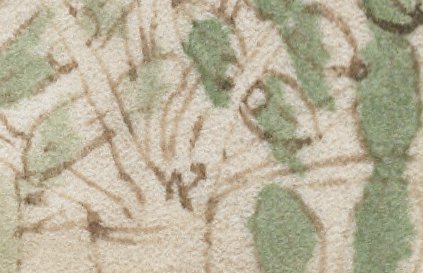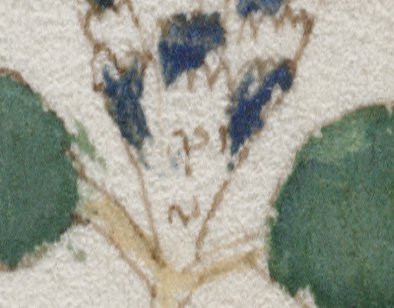I recently found an old email from Sander Manche mentioning his Voynich blog: going through its pages just now, one particular post on letters hidden in Voynich plants jumped out at me. To be precise, it discussed a single symbol that appears to have been hidden in the middle of the plant drawings on both f20r…
…and f32r…
Sander wondered whether this might be an ultra-rare Voynichese letter. It’s not, but I think it’s something even better: a “p”-like letter that appears both in the marginalia and hidden in a separate Voynich plant drawing. I discussed this subject at some length back in 2010, but the upshot is that f9v (the “viola tricolor” page, A.K.A. “love in idleness“), the marginalia on f66r (once) and the marginalia on f116v (twice) all contain this same character. Here’s what they look like (ignore the f4r part):-
Incidentally, there’s an interesting 2011 page from P. Han describing the viola on f9v, concluding (as I think others have done) that it was drawn upside down from life by an artist rather than a botanist, who tried to depict both the front and back views of the plant.
What are these “p”-like shapes for? Why did the author(s) bother to add them? I don’t necessarily buy into René Zandbergen’s idea that the letter-triple on f9v reads “rot”, an instruction to a German-speaking colourist to paint the drawing’s petals red. (For a start, viola tricolor isn’t even slightly red.) But all the same, I’d really like to see multispectral scans of f9v so that we can better work out exactly what is going on there. For now, f9v remains a mystery.
All three appear in Currier A / Hand 1 herbal pages, but otherwise have no obvious connection: I’d suggest that these might have been the first (“primum“) pages of individual quires in the original plaintext. That is, I suspect that these “p”-shapes might in some way be encrypted ‘Herbal A’ quire marks. Fascinatingly, the shapes appear to have been added in a slightly different ink (as per the McCrone report,), so perhaps at a different time: which means that a multispectral scan should probably be able to de-layer all such writing.
Personally, I think the presence of Voynichese in the marginalia (both on f116v and on f17r, with the latter only visible under a UV black-lamp) was already pretty close to a slam-dunk proof that most of the marginalia were added by the original author. But in my opinion, also finding the same “p”-like shape apparently concealed in three plant drawings basically makes this whole link a dead cert.
The bigger point here is that at some time, my long-standing inference that nearly all the Voynich Manuscript’s marginalia were added by the original author(s) will probably become some kind of grudgingly-held mainstream opinion: but what of it? So what?
Personally, I think this is a really big deal, because it elevates the whole “michiton oladabas” tangled mess on f116v from a secondary issue (i.e. “it’s something that could conceivably have just happened to the Voynich Manuscript, so we needn’t really worry about it”) to a primary issue (i.e. “it’s an integral part of the original manuscript and we need to understand it”).
A single multispectral scan of f116v would take less than 10 seconds to perform, and might well open a completely different set of research doors to us. Of course, I’m still a bit disappointed that the Beinecke turned my multispectral proposals down in 2006, but hey: doubtless they’ll catch up with me in the end. I’m normally eight years or so ahead of the game, so set your alarm clock for 2013! 🙂
Update: having put all this together, I discovered that (of course) some of it was anticipated by a nice page posted by Reuben Ogburn in 2004. Oh well!


